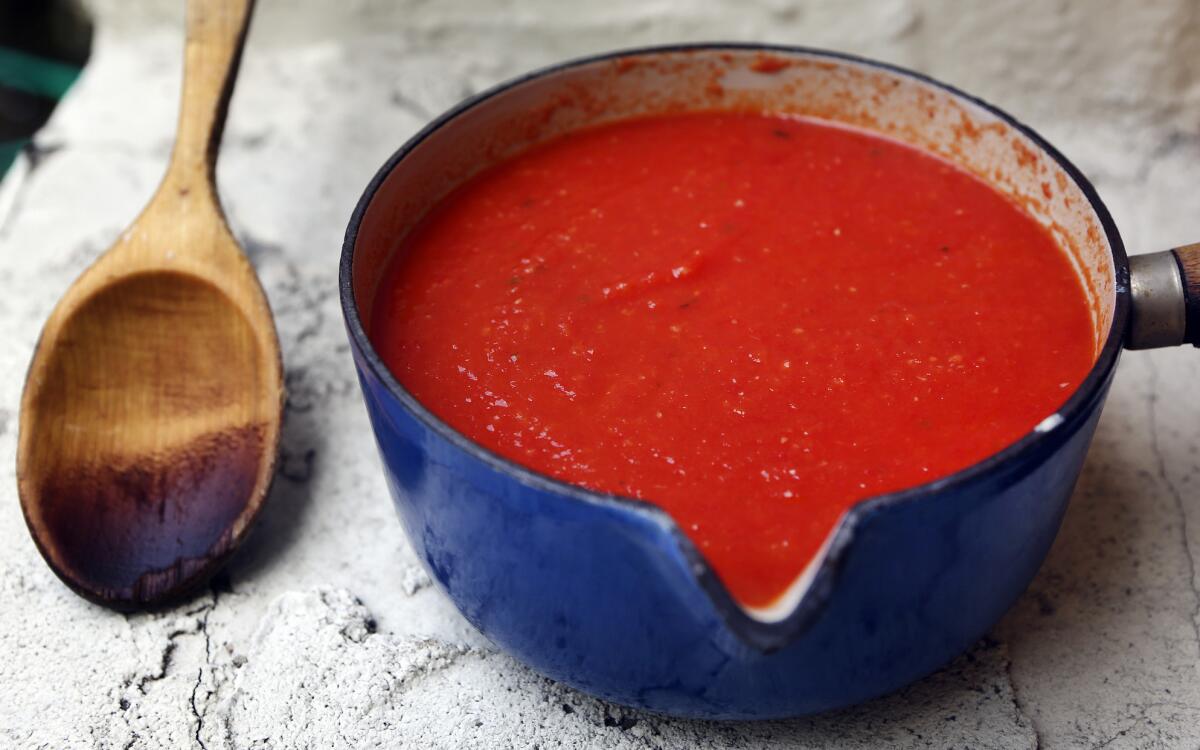Simple marinara sauce

My kitchen is definitely the kitchen of a working food professional — but it’s not a kitchen filled with the latest expensive gadgets. There are plenty of gadgets and tools, mind you, but among my most treasured are workhorse items I’ve bought over the years, for not much money, at garage sales and markets.
Take the inexpensive Moulinex food mill I bought when I lived in Paris in the 1980s from a vendor in the street market on the Boulevard Raspail. I wanted it because a few days after I’d arrived in the city a friend of a friend had invited me to lunch and made me the most delicious soup I had ever tasted, a simple purée of potatoes, leeks, turnips and carrots that he’d put through a food mill and seasoned with salt and abundant pepper. The flavor was wonderful and the consistency divine: It was a purée but unlike any silky soup I’d ever made in a blender.
That street market food mill has endured for 35 years. Its 2-liter work bowl is orange plastic, with notches in the three legs that allow it to sit solidly on top of a bowl. Like most food mills, it has three metal disks — fine, medium and coarse — and a blade attached to a crank. The top half of the knob on my crank handle broke off several years ago, but I can still get a good purchase on the handle by grasping the wobbly bottom half of the knob, as I do weekly starting in late spring and on through the summer when I begin to harvest tomatoes and make tomato sauce for the freezer.
No other tool makes such an easy job of tomato sauce. Because the mill purées and strains food at the same time, I don’t have to peel and seed my tomatoes before I begin cooking. I simply cut them into wedges, throw them into a big pan with olive oil, garlic and basil sprigs, and let the tomatoes cook down until I have a thick, fragrant mush that I put through the fine disk of my food mill. All of the skins and seeds are left behind.
The gadget also makes shorter work of the fava bean purée that I love to make at this time of year. Yes, the dip is easy to make in a food processor — but first you have to skin three pounds of fresh fava beans, which is about as much fun as it sounds. With the food mill I can just cook the shelled beans in salted boiling water; then I put them through the mill and discard the skins.
Chefs love these retro tools for the same reason that home cooks do – because they eliminate the step of pressing blended or processed food through a sieve. This saves a lot of time and effort when cooking large quantities of food. They’re great for mashed potatoes and for soups, for fruit and berry sauces, for applesauce and purées.
If a really silky purée is what you are after, then a blender or food processor followed by a sieve is required. But what I loved about my friend’s soup, and the subsequent French country soups that I have been making with my food mill ever since I bought it, is that they have a rustic consistency.
So how do you choose a good food mill? They can range in price from about $18 to more than $200. The more expensive models are made with heavy stainless steel and are large and durable, suitable for daily use in a restaurant setting. For my own purposes, steady use in summer when I’m making tomato sauce, but usually with no more than a few pounds of tomatoes at a time, a Moulinex or similar inexpensive brand with a 2-quart plastic bowl is just fine.
Whether you go for a stainless steel bowl or a plastic one, it’s important that your food mill sit on top of a bowl without budging, that it have a bowl that has at least a 2-quart capacity, and that you can feel the blade rub against the disk when you turn it. This may mean opening the box and putting the thing together so you can try it.
In a wide, heavy skillet, heat the olive oil over medium heat. Add the garlic and cook, stirring, until fragrant, about 30 seconds. Stir in the tomatoes, basil, sugar and salt and increase the heat to medium-high. When the tomatoes are bubbling briskly, stir and reduce the heat to a gentle simmer.
Cook, stirring from time to time and scraping the sides and bottom of the pan, until the tomatoes have separated from their skins and cooked down to a thick sauce. Timing will depend on the type and ripeness of the tomatoes, anywhere from 30 minutes to an hour.
Remove the basil sprigs from the sauce and gently scrape off the sauce that clings to them.
Place the mixture in a food mill fitted with the fine blade, and press the tomato sauce into a bowl. Taste and adjust the seasoning as desired. Use at once, refrigerate for up to 4 days, or freeze in small containers or freezer bags.
Get our Cooking newsletter.
Your roundup of inspiring recipes and kitchen tricks.
You may occasionally receive promotional content from the Los Angeles Times.















